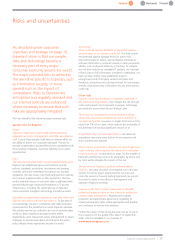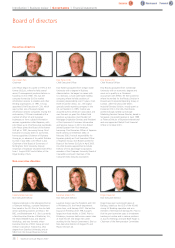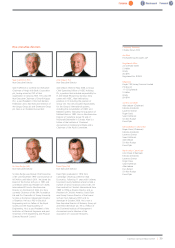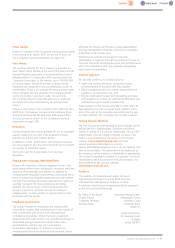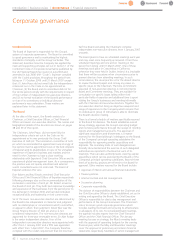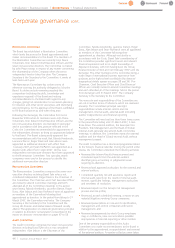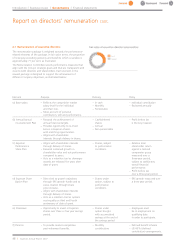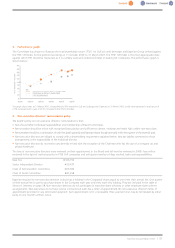Experian 2007 Annual Report Download - page 47
Download and view the complete annual report
Please find page 47 of the 2007 Experian annual report below. You can navigate through the pages in the report by either clicking on the pages listed below, or by using the keyword search tool below to find specific information within the annual report.
into account by the Committee in assessing whether to
recommend the external auditors for re-appointment.
These included:
•The quality of reports provided to the Audit Committee
and the Board and the quality of advice given;
•The level of understanding demonstrated of the Group’s
businesses and its sectors; and
•The objectivity of the external auditors’ views on the
controls around the Group and their ability to co-
ordinate a global audit working to tight deadlines.
Following the completion of the first year-end audit
process, the Committee will assess the effectiveness of the
external audit process covering all aspects of the audit
service provided by the Company’s external auditors. The
Committee will also review a report on the external
auditors’ own quality control procedures.
The Committee recognises that auditor independence is
an essential part of the audit framework and the
assurance it provides. Non-audit fees paid to the
Company’sauditors, PricewaterhouseCoopers LLP,in
respect of the period under review exceeded the audit fee
and included fees relating to the demerger. The
Committee has established control processes to safeguard
the objectivity and independence of the external auditors
and to ensurethat the independence of the audit work
undertaken by the external auditors is not compromised.
The Committee has established a policy covering the type
of non-audit work that can be assigned to the external
auditors. The auditors may only provide such services
provided that such advice does not conflict with their
statutoryresponsibilities and ethical guidance. These
services are:
•Further assurance services - where the external auditors’
deep knowledge of the Group’s affairs means that they
may be best placed to carry out such work. This may
include, but is not restricted to, shareholder and other
circulars, regulatory reports and work in connection
with acquisitions and divestments.
•Taxation services - where the external auditors’
knowledge of the Group’s affairs may provide
significant advantages which other parties would not
have. Wherethis is not the case, the work is put out to
tender.
•General - in other circumstances, the external auditors
may provide services, provided that proposed
assignments are put out to tender and decisions to
awardwork aretaken on the basis of demonstrable
competence and cost effectiveness. However, certain
areas of work are specifically prohibited including work
related to accounting records and financial statements
that will ultimately be subject to external audit;
management of, or significant involvement in, internal
audit services; any work that could compromise the
independence of the external auditors; and any other
work that is prohibited by UK ethical guidance.
The Audit Committee Chairman’s pre-approval is required
before the Company uses non-audit services that exceed
financial limits set out in the policy.
The Committee receives half-yearly reports providing
details of assignments and related fees carried out by the
external auditors in addition to their normal work. Fees in
respect of such assignments carried out in the year under
review are set out in note 5 to the financial statements on
page 81.
Corporate Governance Committee
In addition to the principal Board committees, the Board
has established a number of other committees including a
Corporate Governance Committee with written terms of
reference to assist in its monitoring of corporate
governance issues. The Committee’s responsibilities
include keeping under review all legislative, regulatory and
corporate governance developments that might affect the
Company’soperations and making recommendations to
the Board in relation to them. The members of the
Corporate Governance Committee are John Peace
(Chairman), Don Robert (Chief Executive Officer), Sir Alan
Rudge (the senior independent director) and Charles
Brown (Company Secretary).
Accountability and Audit
The Board acknowledges that it is responsible for the
Group’s system of internal control and for reviewing its
effectiveness. Such a system is designed to manage rather
than eliminate the risk of failure to achieve business
objectives and can provide reasonable, but not absolute,
assurance against material misstatement or loss. The
Board reviews annually the effectiveness of the key
procedures which have been established to provide
internal control.
The Boardconfirms that thereis an ongoing process for
identifying, evaluating and managing the significant risks
faced by the Group, including those risks relating to
social, environmental and ethical matters. This process
was in place throughout the period under review and up
to the date of approval of the Annual Report and meets
the requirements of the Code. For certain joint
arrangements, the Board places reliance upon the systems
of internal control operating within the partners’
infrastructure and the obligations upon partners’ Boards
relating to the effectiveness of their own systems. In the
Board’s view, the information it received was sufficient to
enable it to review the effectiveness of the Group’s system
of internal control in accordance with the ‘Internal Control
Revised Guidance for Directors’ contained in the Code.
The Audit Committee has kept under review the
effectiveness of this system of internal control and has
reported regularly to the Board.
The key procedures, which operated throughout the year,
were as follows:
Risk assessment:
•The Group set out its objectives clearly as part of its
planning process and organisation design. These
objectives were then incorporated as part of the
planning cycle and supported by the use of both
financial and non-financial key performance indicators.
Experian Annual Report 2007 |45


